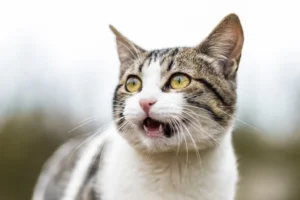After surgery, you may notice your cat panting, which can be a cause for concern. But why do cats pant after surgery? Let’s explore the reasons behind this behavior and what you can do to help your furry friend recover comfortably.
Cats pant after surgery due to the effects of anesthesia and stress.
Understanding the effects of anesthesia on cats
Anesthesia is a crucial tool in veterinary surgery, ensuring that our feline friends undergo procedures comfortably and without pain. However, anesthesia can have a direct impact on a cat’s respiratory system, leading to panting post-surgery. When cats are under anesthesia, their breathing may become shallow, causing a decrease in oxygen levels in the body. This can result in panting as the body works to compensate for the reduced oxygen.
It’s essential to understand that cats are obligate nose breathers, meaning they primarily breathe through their noses. When under anesthesia, this natural breathing pattern can be disrupted, causing cats to pant as they struggle to regulate their breathing. This panting is a common response to the effects of anesthesia on a cat’s respiratory system.
For more detailed information on how anesthesia affects cats, you can refer to this helpful resource on anesthesia in cats.
Recognizing signs of stress in cats post-surgery
After surgery, cats may experience stress due to various factors, such as pain, unfamiliar environments, and changes in routine. Recognizing signs of stress in your feline companion is crucial to addressing their needs and ensuring a smooth recovery process. Common signs of stress in cats post-surgery include excessive grooming, hiding, decreased appetite, and yes, panting.
Panting in cats post-surgery can be a sign of stress, as they may feel anxious or uncomfortable during the recovery period. It’s essential to create a calm and quiet space for your cat to rest and recover, minimizing potential stress triggers. Additionally, providing comforting stimuli such as familiar bedding and toys can help alleviate stress and reduce panting episodes.
Remember, every cat is unique, and their response to surgery and recovery will vary. By recognizing the signs of stress in your feline friend and addressing their needs accordingly, you can support them through the post-surgery period effectively.
As a friendly reminder, always consult your veterinarian if you have any concerns about your cat’s recovery post-surgery. Your vet can provide tailored advice and support to ensure your cat’s well-being throughout the recovery process.
Providing a comfortable recovery environment at home
After surgery, your cat will need a peaceful place to rest and recover. Create a quiet space with their favorite bed, toys, and a litter box nearby. Ensure the area is warm and draft-free to help them feel comfortable. Providing plenty of fresh water and nutritious food will aid in their healing process. Additionally, try to limit loud noises and keep interactions calm to reduce stress.
To help your cat relax, consider using pheromone sprays or diffusers designed to create a calming atmosphere. These products can help reduce anxiety and promote faster recovery. It’s essential to monitor your cat’s behavior and adjust their environment accordingly to ensure they are comfortable and safe during their recovery period.
Monitoring your cat’s breathing post-surgery
After surgery, it’s crucial to keep a close eye on your cat’s breathing to ensure they are recovering well. Panting in cats can be a sign of pain, discomfort, or stress, so it’s essential to monitor their breathing patterns. If you notice excessive panting, shallow breathing, or other abnormal respiratory signs, it’s crucial to contact your veterinarian immediately for further evaluation.
One way to monitor your cat’s breathing is to observe their chest movements. A relaxed and steady breathing pattern with minimal effort is typically a good sign. However, rapid or labored breathing could indicate potential complications post-surgery. Keep an eye on any changes in your cat’s breathing patterns and seek professional help if you have any concerns.
Additional tip: Consider using a pet monitoring camera to keep an eye on your cat’s breathing and overall condition while you are away. This can provide peace of mind and ensure prompt action if any issues arise.
Remember, your cat’s comfort and well-being are a top priority during the recovery period, so pay close attention to their behavior and seek veterinary assistance if needed. Creating a calm environment and monitoring their breathing post-surgery will help ensure a smooth and successful recovery for your feline friend.
Hydration and nutrition for post-surgery recovery
After surgery, it’s crucial to keep your furry friend well-hydrated to aid in their recovery process. Make sure they have access to fresh water at all times to prevent dehydration. If your cat is not drinking enough, consider providing wet food or a special liquid diet recommended by your veterinarian to help with hydration. Adequate hydration can assist in reducing panting and promoting healing.
When it comes to nutrition, ensure your cat is receiving balanced meals that are easy to digest and support their immune system. Opt for high-quality, easily digestible foods that are rich in nutrients essential for recovery. Including Omega-3 fatty acids in their diet can also help reduce inflammation and promote healing. Remember, a well-nourished body can bounce back faster post-surgery, helping to alleviate panting and discomfort.
Encouraging gentle activity and mental stimulation
In addition to hydration and nutrition, encouraging light activity can aid in your cat’s recovery. Gentle exercises like stretching or short walks can promote blood circulation and prevent muscle stiffness, contributing to a smoother healing process. Mental stimulation is also vital during this time to keep your furry friend engaged and prevent boredom, which can lead to stress and prolonged recovery.
Engage your cat in interactive play sessions using toys they love, or try introducing puzzle feeders to keep their mind active. This can help distract them from any post-surgery discomfort and reduce panting caused by anxiety or restlessness. Remember, a healthy balance of physical activity and mental stimulation is key to a speedy recovery for your feline companion.
Follow-up care and veterinary check-ups
After your cat undergoes surgery, it’s essential to prioritize follow-up care and schedule regular veterinary check-ups to ensure their proper healing and recovery process. Your veterinarian will monitor your feline friend’s progress, address any concerns, and make sure they are on the right track to full health.
Did you know? Cats may pant after surgery as a result of pain or discomfort, so it’s crucial to keep a close eye on your pet’s well-being during the recovery process. If you notice excessive panting or any other concerning symptoms, don’t hesitate to contact your vet immediately for guidance and support.
Remember, your cat’s health is in your hands, so be proactive in seeking professional advice and guidance from your veterinarian. By staying vigilant and following through with follow-up care and check-ups, you can ensure your furry companion’s well-being and happiness for years to come.
Additional tip: Keep a journal of your cat’s recovery progress, including any changes in behavior, appetite, or energy levels. This information can be valuable to share with your vet during check-ups and help them better assess your cat’s recovery process.
For more information on post-surgery care and recovery, check out this helpful resource from the American Association of Feline Practitioners: Post-Surgery Care for Cats.
Alex, a passionate animal lover, has experience in training and understanding animal behavior. As a proud pet parent to two dogs and three cats, he founded AnimalReport.net to share insights from animal experts and expand his knowledge of the animal kingdom.









